The Total Hydrocarbon Analyzers Market is estimated to be valued at USD 559.0 million in 2025 and is projected to reach USD 910.6 million by 2035, registering a compound annual growth rate (CAGR) of 5.0% over the forecast period.

The total hydrocarbon analyzers market is witnessing strong growth fueled by increasing demand for precise monitoring of hydrocarbon emissions and product quality in the oil and gas sector. Regulatory requirements for environmental compliance and process optimization have led to widespread deployment of advanced analyzers across refining and petrochemical facilities. Improvements in analyzer sensitivity and response times have enhanced process control and emissions management.
Growing awareness of environmental standards and the push towards cleaner energy have further supported market expansion. The adoption of portable analyzers has increased operational flexibility, allowing on-site analysis and quicker decision-making.
The ongoing investments in refinery upgrades and expansions globally are expected to sustain demand for hydrocarbon analyzers. Segmental growth is expected to be led by the Flame Ionization Detector (FID) type due to its reliability, portable modular analyzers for ease of use, and petroleum refineries as the main end-use industry.
The market is segmented by Type, Modularity, and End Use and region. By Type, the market is divided into Flame Ionization Detector (FID), Gas Chromatographs (GCs), Catalytic Sensors, Photo-Ionization (PID), and Infra-Red (IR) Sensors. In terms of Modularity, the market is classified into Portable and Benchtop. Based on End Use, the market is segmented into Petroleum Refineries, Tobacco Industry, Ethylene Production Plants, Environmental Monitoring Stations, Academic Research Institutes & Laboratories, and Others. Regionally, the market is classified into North America, Latin America, Western Europe, Eastern Europe, Balkan & Baltic Countries, Russia & Belarus, Central Asia, East Asia, South Asia & Pacific, and the Middle East & Africa.
The market is segmented by Type, Modularity, and End Use and region. By Type, the market is divided into Flame Ionization Detector (FID), Gas Chromatographs (GCs), Catalytic Sensors, Photo-Ionization (PID), and Infra-Red (IR) Sensors. In terms of Modularity, the market is classified into Portable and Benchtop. Based on End Use, the market is segmented into Petroleum Refineries, Tobacco Industry, Ethylene Production Plants, Environmental Monitoring Stations, Academic Research Institutes & Laboratories, and Others. Regionally, the market is classified into North America, Latin America, Western Europe, Eastern Europe, Balkan & Baltic Countries, Russia & Belarus, Central Asia, East Asia, South Asia & Pacific, and the Middle East & Africa.
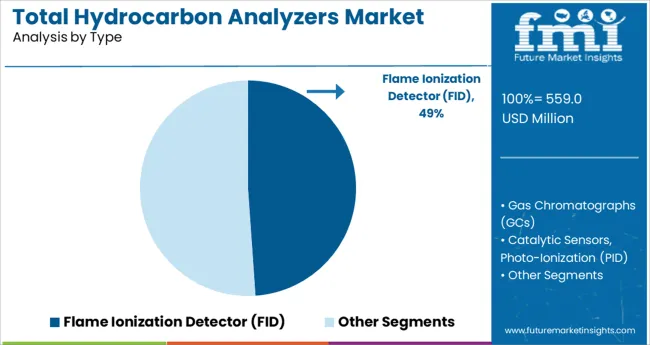
The Flame Ionization Detector segment is projected to contribute 48.9% of the total hydrocarbon analyzers market revenue in 2025, maintaining its dominance as the preferred detection technology. FID analyzers are favored for their accuracy, sensitivity, and ability to detect a wide range of hydrocarbons. Their robustness and relatively simple operation make them suitable for continuous monitoring in demanding refinery environments.
Additionally, FID technology provides rapid response times essential for real-time process adjustments. These advantages have established FID as the standard choice for hydrocarbon analysis in many industrial applications. The segment’s growth is supported by its proven reliability and ongoing enhancements in detection capabilities.
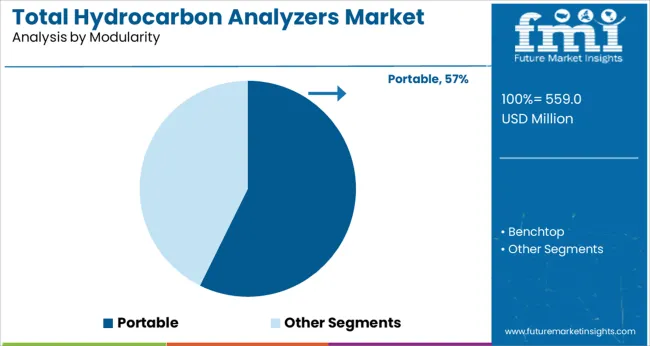
The Portable segment is expected to account for 57.3% of the market revenue in 2025, leading in modularity preference. Portable analyzers offer significant advantages in terms of flexibility and mobility, allowing operators to conduct spot checks and troubleshoot issues across different locations within a refinery.
The ability to perform on-the-spot measurements reduces downtime and supports faster operational decisions. Their compact design and ease of use have increased adoption among field technicians and maintenance teams.
Portability also facilitates compliance checks and environmental audits without the need for fixed installation. As operational efficiency remains a priority, portable analyzers are likely to sustain their leading market position.
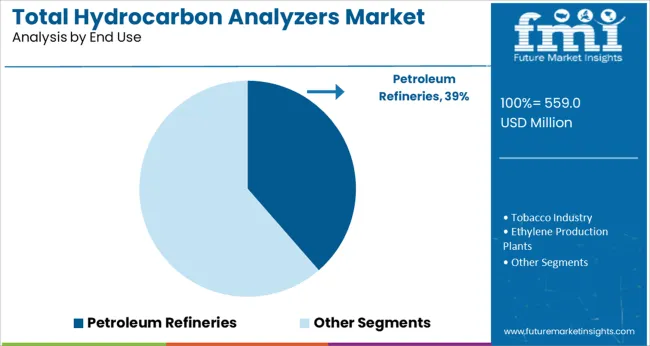
The Petroleum Refineries segment is projected to hold 38.6% of the total hydrocarbon analyzers market revenue in 2025, retaining its lead as the primary end-use industry. Refineries require continuous hydrocarbon monitoring to optimize product yields and comply with stringent environmental regulations.
The complexity of refining processes demands accurate measurement of hydrocarbon concentrations to maintain safety and efficiency. Investments in refinery modernization and emission control systems have driven demand for advanced analyzers.
Furthermore, the expanding global refining capacity, particularly in emerging regions, supports sustained growth in this segment. The critical role of hydrocarbon analyzers in ensuring operational excellence positions petroleum refineries at the forefront of market demand.
Hydrocarbon processing, which is one of the most prominent industries in the world, has numerous regulations, standards, and norms to comply with for smooth production. As the sector is bound to maintain the highest safety norms, effective hydrocarbon analysis is of significant importance for hydrocarbon processing for achieving a high level of productivity.
This generally requires a wide range of hydrocarbon analysis measurements and analyzing devices such as flame ionization detectors, catalytic sensors, photo-ionization, gas chromatographs, infra-red sensors, and others to ensure safe and optimized processing.
Hence, rapid expansion of the hydrocarbon processing industry across prominent economies such as the U.S., China, India, Germany, and others is expected to create lucrative growth opportunities for the growth in the total hydrocarbon analyzers market.
Despite numerous advantages associated with the use of total hydrocarbon analyzers, the inability of these analyzers to measure the concentration of different compounds and stringent regulatory approval standards for the launch of new devices are some of the factors restraining the growth in the market.
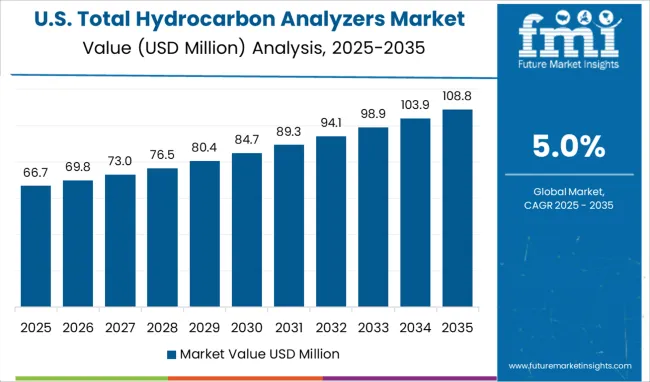
Future Market Insights reveals that North America is estimated to grow at a robust CAGR in the global total hydrocarbon analyzers market between 2025 and 2035.
Total hydrocarbon analyzers are finding a wide range of applications across environmental monitoring, ethylene production, petroleum refining, and others sector, owing to their features such as integrated systems, flexible temperature ranges, and precision analysis.
Citing this trend, key manufacturers are aiming at introducing advanced products. For instance, Emerson, an American multinational corporation recently announced unveiling its new Rosemount NGA 2000 HFID Heated Total Hydrocarbon Analyzer Module that uses advanced flame ionization detection (FID) technology for accurate analysis. A multiplicity of such new product launches is anticipated to favor the growth in the North America market.
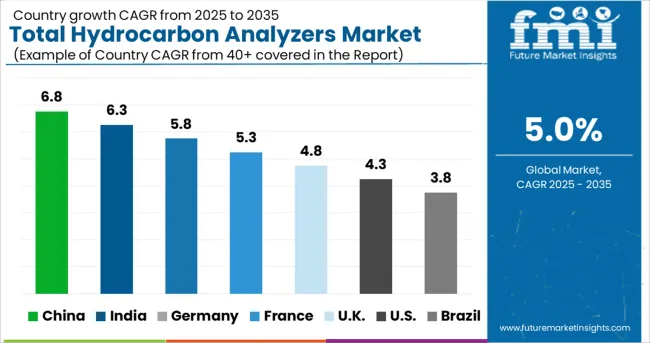
FMI reveals that Asia Pacific excluding Japan is expected to emerge as a highly lucrative market for total hydrocarbon analyzers during the forecast period 2025-2035.
As the demand for petroleum products such as gasoline, diesel, LPG, and others is rising, key petroleum refineries industry players are aiming to increase their refining efficiency and expand production capacity for addressing the growing demand.
For instance, Bharat Petroleum Corporation Ltd, a petroleum refineries company based in India announced investing around 532.4 Bn to enhance petrochemical capacity, improve refining efficiency, and increase the production of petroleum derivatives by 2024.
As total hydrocarbon analyzers play a vital role in gas chromatography applications during petroleum refining, such developments are projected to augment the sales in the Asia Pacific excluding Japan market.
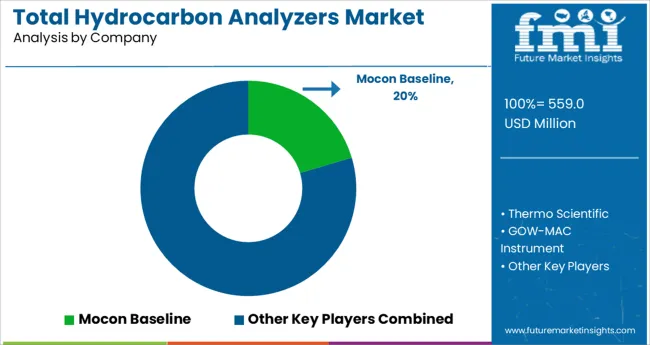
Some of the leading players in the total hydrocarbon analyzers market are Mocon Baseline, Thermo Scientific, GOW-MAC Instrument, Teledyne, Siemens Process Analytics, ADOS GmbH, AMETEK, OI Analytical, AGC Instruments, GE Analytical Instruments, Servomex, and others.
Attributed to the presence of such a large number of participants and increasing product launches with advanced connectivity and multi-functional features, the market is highly competitive.
| Report Attribute | Details |
|---|---|
| Base Year for Estimation | 2024 |
| Historical Data | 2020 to 2024 |
| Forecast Period | 2025 to 2035 |
| Quantitative Units | Revenue in million, Volume in Kilotons and CAGR from 2025 to 2035 |
| Report Coverage | Revenue Forecast, Volume Forecast, Company Ranking, Competitive Landscape, Growth Factors, Trends and Pricing Analysis |
| Segments Covered | Type, Modularity, End Use, Region |
| Countries Covered | North America; Latin America; Europe; CIS & Russia; APEJ; Japan; Middle East and Africa |
| Key Companies Profiled | Mocon Baseline; Thermo Scientific; GOW-MAC Instrument; Teledyne; Siemens Process Analytics; ADOS GmbH; AMETEK; OI Analytical; AGC Instruments; GE Analytical Instruments; Servomex; Others |
| Customization | Available Upon Request |
The global total hydrocarbon analyzers market is estimated to be valued at USD 559.0 million in 2025.
It is projected to reach USD 910.6 million by 2035.
The market is expected to grow at a 5.0% CAGR between 2025 and 2035.
The key product types are flame ionization detector (fid), gas chromatographs (gcs), catalytic sensors, photo-ionization (pid) and infra-red (ir) sensors.
portable segment is expected to dominate with a 57.3% industry share in 2025.






Full Research Suite comprises of:
Market outlook & trends analysis
Interviews & case studies
Strategic recommendations
Vendor profiles & capabilities analysis
5-year forecasts
8 regions and 60+ country-level data splits
Market segment data splits
12 months of continuous data updates
DELIVERED AS:
PDF EXCEL ONLINE
Total Reflection X-Ray Fluorescence Spectrometer Market Size and Share Forecast Outlook 2025 to 2035
Total Dust Detector Market Size and Share Forecast Outlook 2025 to 2035
Total Aflatoxin Test Kit Market Size and Share Forecast Outlook 2025 to 2035
Total Knee Replacement Market Size and Share Forecast Outlook 2025 to 2035
Total Artificial Heart Market
Total Iron-Binding Capacity Reagents Market
Total Carbon Analyzers Market Growth - Trends & Outlook 2025 to 2035
Hydrocarbon Accounting Solution Market Size and Share Forecast Outlook 2025 to 2035
Hydrocarbon and Silicone Coolant Market Size and Share Forecast Outlook 2025 to 2035
Hydrocarbon Cleaning Agents Market Size and Share Forecast Outlook 2025 to 2035
Hydrocarbon Tester Market Size and Share Forecast Outlook 2025 to 2035
Analyzing Hydrocarbon Accounting Solution Market Share & Industry Leaders
Europe Hydrocarbons Accounting Solution Market Insights – Demand & Growth 2025 to 2035
Metal Analyzers Market Size and Share Forecast Outlook 2025 to 2035
Power Analyzers Market
Urine Analyzers Market
Silica Analyzers Market
Genetic Analyzers Market Size and Share Forecast Outlook 2025 to 2035
Albumin Analyzers Market Size and Share Forecast Outlook 2025 to 2035
NMR Fat Analyzers Market Size and Share Forecast Outlook 2025 to 2035

Thank you!
You will receive an email from our Business Development Manager. Please be sure to check your SPAM/JUNK folder too.
Chat With
MaRIA